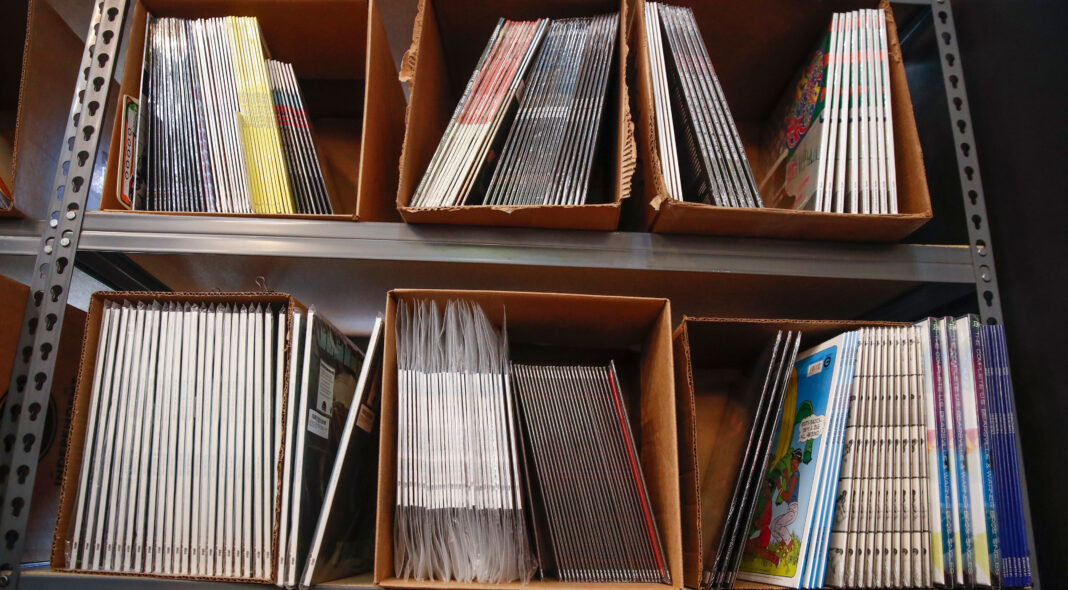Latest stats say that vinyl is having a moment. We know, we know – you read this story last year. And the year before that. But in 2020, sales of vinyl were the highest since the glory days of the nineties, when Oasis and Blur were battling for the charts and the music industry was booming. According to data published by the BPI, 18% of all albums purchased this year were vinyl, up 10% on last year to 4.8 million – an increase for the thirteenth year in a row.
So what’s really driving the resurgence? A quick glance at the most-bought vinyl of the year will have you thinking it’s the same old story: classic rock-loving Boomers with a disposable income, replacing their record collection (which they previously replaced with CDs). But the reality is a little more complex and in fact, based in online culture.
Which albums are topping the vinyl charts?
It stands to reason that classic albums top vinyl charts. There is no escaping the fact that vinyl is a lot less convenient than streaming, CDs or even cassettes. For starters, it takes up space, so at the beginning stages of a “resurgence”, or if you are just making a whimsical dabble back into collecting, you probably want to start with the classics – albums that stand the test of time, that you know you’ll want to listen to again and again, the ones that will look cool in a frame or on a shelf.
But dig a little further down the list and some interesting trends start to pop out. Harry Styles, Lady Gaga, Billie Eilish and Dua Lipa – all artists with a huge Gen Z fanbase – saw significant vinyl sales this year. Stan culture sees online fans communities competitively showing support for their favourite musicians. Stans want to see their beloved artists charting by streaming their songs on repeat. They flood awards polls with entries to make sure they take home the trophy and, individually, Stans support their favourites financially by buying merch, snapping up concert tickets and getting a new release in every format going.
A dive into the Haim Subreddit back in the summer and you’d find fans excitedly sharing photos of their early vinyl copies of ‘Women In Music Pt.III‘, complete with an autograph from the band. Swifties followed suit in the autumn, saving up their pocket money to buy all 18 collectible formats of ‘Folklore’. BTS, similarly, love an album bundle, each one offering something slightly different, which encourages superfans to fork out for every bundle. And even Paul McCartney, who hardly needs the cash, just encouraged fans to “collect” all five colour bundles of his new album each including a different coloured face mask, T-shirt and exclusive track. These label-driven sales strategies are an effective way to make money but the truth is, they are only effective because the fans are already heavily invested in the artist.
The psychology of the tangible purchase
A psychological study from 2003 suggests that physical formats and the ability for a consumer to say “this is mine”, builds a stronger connection with a piece of music, with the overall vinyl “experience” trumping developments in audio quality. With a Spotify account, you don’t really own anything, so therefore what does it matter if you listen to a few tracks of an album and never make it to the end? With a physical reminder of the music in your home, the connection and likelihood to revisit an album is increased.
Where 2020 delivered us a lot more time spent indoors, many of us searched for new hobbies. Music fans were robbed of the live experience, so looked for other ways to indulge their obsession. Online vinyl marketplace, Discogs, saw a 27% increase in sales since the pandemic hit, with many clearly turning to vinyl collecting to while away the hours.
Switched-on music fans were aware of the impact the pandemic was having on the industry they loved and those that could afford to. Perhaps, in a year where musicians were struggling so much, fans were more inclined to spend on music, the reality of a world without it suddenly becoming a frighteningly real prospect.
Online trends impacting physical purchases
Remember back in October when the world went nuts for a cranberry juice-drinking TikTokker skateboarding to Fleetwood Mac’s ‘Dreams’? After Doggface’s meme went viral, ‘Dreams’ re-entered the Top 40 for the first time since 1977, proof – for anyone that still needed it – that TikTok has an impact on the charts. What’s interesting here though is how TikTok might be impacting physical music sales. Fleetwood Mac’s ‘Rumors’ was the best-selling vinyl LP of the year – a climb from 3rd position last year. Could it be said, then, that Doggface’s skateboarding stunt, caused people to fall in love with Fleetwood Mac to the extent that they not only streamed ‘Dreams’ a few times, but they bought the vinyl of the album the song features on?
It’s distinctly possible. Much like bread baking and crochet and home brewing trends, millennials and Gen Z have demonstrated time and again a desire for cottagecore pursuits; things that involve putting down their phones for a while and switching off. Whether they immediately ‘gram their new loaf or macrame pot holder afterwards is by the by – for a while the joy comes from absorbed in something other than the endless scroll. In a year where the news and social media feeds has been so heavy with bad news, you can see the appeal of sticking on an album and losing yourself in the sleeve notes. But whether the motivation is your own mental wellbeing, an obsession with your favourite artist, or giving a little boost to an industry on its knees, the growth in vinyl is providing a new potential source of income for musicians when they need it most. Long may it continue.



